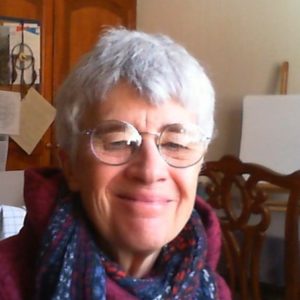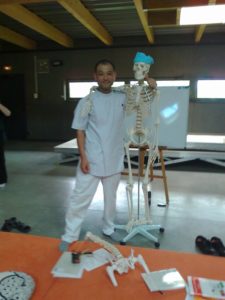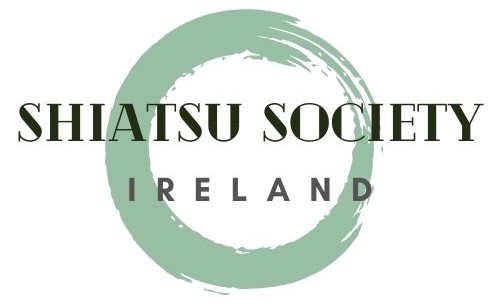Frances Hassett details her Shiatsu journey along with other practices from training onwards. You can visit Frances’ website www.inner-nature-art-therapies.com to read more about the therapies she offers.
Round the world with Shiatsu
 Learning Shiatsu has been an exciting journey for me that started in France. I embarked on my training in 2007 to qualify in 2011. My examination day arrived, and I remember feeling so stressed. I had to go to Paris to do my theoretical, practical and oral exams and despite having a sleepless night and being virtually speechless the next day, I passed.
Learning Shiatsu has been an exciting journey for me that started in France. I embarked on my training in 2007 to qualify in 2011. My examination day arrived, and I remember feeling so stressed. I had to go to Paris to do my theoretical, practical and oral exams and despite having a sleepless night and being virtually speechless the next day, I passed.
My experience with shiatsu began in St Ives, Cambridgeshire c. 2000. I was a rookie tai chi instructor and one of my students was a burley retired detective from the Cambridgeshire constabulary. He was extoling the virtues of shiatsu having just qualified as a practitioner. He was so enthusiastic, and he gave me a blow-by-blow account of what to expect from a treatment and how it worked. Around that time a horrific murder had been committed. Two small children from the Soham primary school had been abducted by the caretaker of the school. The crime was so emotionally draining that the constabulary had employed therapeutic councillors as well as my detective friend to provide shiatsu to work alongside the officers. He was telling me how he worked to overcome the trauma being experienced by the team of detectives running the case, and just using his thumbs! Not long after, I moved to France in 2003, and for a good few years I forgot about shiatsu until one Saturday morning, having coffee in Sanmatan market, and reading our local paper, La Depeche, there was an advert for a certificated course in shiatsu offered by the French Federation of classic shiatsu about to start in Toulouse, my interest was at once re-kindled and I enrolled, I remember feeling thrilled. Clearly, I was meant to be doing shiatsu.
By the time I qualified I had accomplished training in 4 shiatsu schools, which also included studying at the Tokyo therapeutic school. I began learning the Tokada school, which is a very gentle form of shiatsu and had been brought to France by Isabella Laading an experienced practitioner and author. The Tokado style was very simple, flowing and gentle, the therapeutic touch seemingly imperceptible, but profoundly effective. This was good practice as you had to really connect with your client energetically and we devoted much time in meditation and practicing Qi Gong.
Later, I went on to join Daniel Menini also in Toulouse who was one of the gentlest and most committed teachers I think I’ve ever met and so supportive of his students and a devoted exponent of shiatsu. I was with him for three years. The style was Namikoshi and totally different from Tokado. Namikoshi relied on strict adherence to protocols, in other words, our proximity to the client, the position of the thumb and hands and how we moved around the body. The protocols determined the exact dosage of touch, so you had to always pay strict attention to your position. The location of the hands was of paramount importance to ensure the quality of touch and without harming the metacarpals in our hands through incorrectly applied pressure. They also ensured that we maintained our personal somatic energy levels. We always had to have our hara and heart facing our clients to make and keep strong the energetic connection with our client’s own energetic pathways and fields. For some, the Namikoshi style appeared ‘brutal’ particularly for anyone spectating. I recall one examiner watching me in Paris who said my therapeutic touch was too strong. However, the receiver said it was perfect and not overly intense. I remember feeling she had problems in her spine, the lower back. At the end she told me she had badly miscarried her first infant and this had led to spinal complications. The brief session with me, she told me, had liberated that blocked energy and she felt freer. She was also crying as she said I had released emotions that had lain dormant since the incident. It was lovely to receive a heartfelt hug from my examiner. I celebrated afterwards in a Parisian café before catching the TGV back to Toulouse and a long grateful sleep on the train.
During 2010 I returned to the UK for a brief sojourn and undertook a shiatsu course there. The style was essentially Masunaga but had been modified as the teacher wanted to develop her own school by introducing yoga asanas into her shiatsu style. It was an interesting experiment. I continued to learn Masunaga with my Tai Chi teacher in Toulouse Regine Gastou and again this was a completely different school to what I had learnt before.
In doing Tai Chi, which I had practiced since 1998, I had been taught to follow the ‘master’. I was a student of Master Tung studying with Anya Meot in France and went to courses in various other places such as Sicilia and Spain. My studies took me to exotic locations, practicing on beaches with the Mediterranean lapping at our feet. I was assiduous in this belief of maintaining the purity of the lineage. There were good reasons why you keep the tradition alive, which had been handed down for thousands of years and my philosophy extended to learning and practicing Shiatsu, as well as Yoga and other healing arts; for example, Do In and Qi Gong.
 In 2013 I was part of a French group that went to Japan to attend the Tokyo therapeutic school to learn Kuretake Shiatsu with Masanori Okomoto, as well as An-ma massage, and Japanese acupuncture. Since that time, I have stayed faithful to this style, and I have attended many courses in France and with Master Okomoto to maintain my skill levels and to learn different protocols for treating different aspects of health. I cannot say that Kuretake is particularly different from other forms of Shiatsu, but it has its own style and philosophy and follows an ancestry through Masanori Okomoto who I was privileged to work with. Daniel retired from Toulouse University where he taught Japanese and joined his Japanese family full time in Tokyo. He was a sad loss to us in France but gratefully he kept returning for the purpose of keeping Kuretake Shiatsu alive where it now has a great following and many different training centres. I hope to return soon to do some more courses.
In 2013 I was part of a French group that went to Japan to attend the Tokyo therapeutic school to learn Kuretake Shiatsu with Masanori Okomoto, as well as An-ma massage, and Japanese acupuncture. Since that time, I have stayed faithful to this style, and I have attended many courses in France and with Master Okomoto to maintain my skill levels and to learn different protocols for treating different aspects of health. I cannot say that Kuretake is particularly different from other forms of Shiatsu, but it has its own style and philosophy and follows an ancestry through Masanori Okomoto who I was privileged to work with. Daniel retired from Toulouse University where he taught Japanese and joined his Japanese family full time in Tokyo. He was a sad loss to us in France but gratefully he kept returning for the purpose of keeping Kuretake Shiatsu alive where it now has a great following and many different training centres. I hope to return soon to do some more courses.
(Image: Masoni Okamoto (with a friend) teaching at a Shiatsu course in Bretagne, France, 2012)
In working across different countries, France, Japan, the UK, and now Ireland, and learning different styles of Shiatsu I bring a wealth of knowledge and experience to my practice. The last two years have been frustrating for me as it has not been possible to practice Shiatsu. Studying and working in France is a very different experience from Ireland and it’s great to see the same commitment to maintaining good standards of practice and excellence with the enthusiasm promulgated by the Irish Shiatsu Association’s teachers. It is a great shame that the western medical profession won’t recognise the health benefits of Shiatsu and I think if it did there would be fewer patients clogging up the hospitals. In Tokyo, for example you will see Shiatsu cabinets along the main thoroughfares where in Ireland you see pharmacists. In Japan people will visit a shiatsu practitioner to stay well. As Masunaga states, when symptoms take hold of a body it is almost too late to overcome the pathology. We have along way to go in the west before we wholeheartedly practice preventative medicine.

